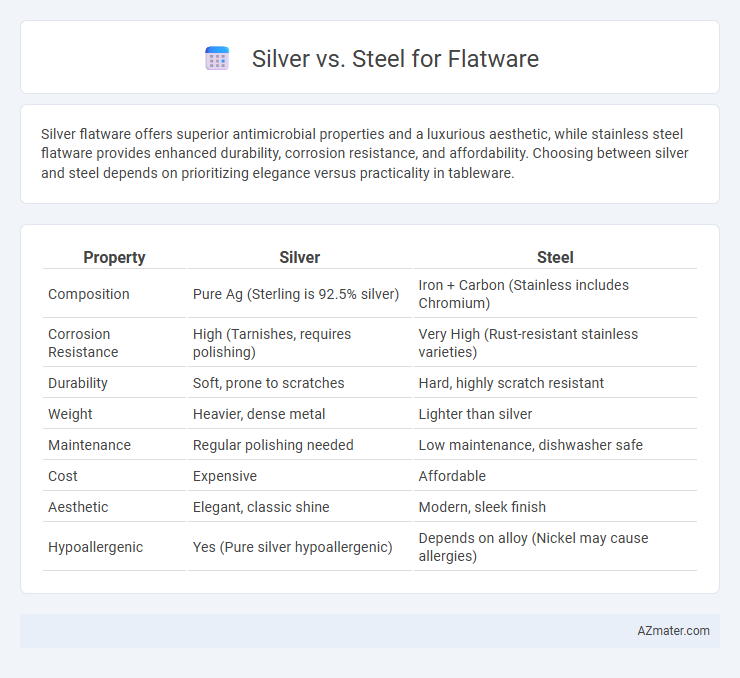Silver flatware offers superior antimicrobial properties and a luxurious aesthetic, while stainless steel flatware provides enhanced durability, corrosion resistance, and affordability. Choosing between silver and steel depends on prioritizing elegance versus practicality in tableware.
Table of Comparison
| Property | Silver | Steel |
|---|---|---|
| Composition | Pure Ag (Sterling is 92.5% silver) | Iron + Carbon (Stainless includes Chromium) |
| Corrosion Resistance | High (Tarnishes, requires polishing) | Very High (Rust-resistant stainless varieties) |
| Durability | Soft, prone to scratches | Hard, highly scratch resistant |
| Weight | Heavier, dense metal | Lighter than silver |
| Maintenance | Regular polishing needed | Low maintenance, dishwasher safe |
| Cost | Expensive | Affordable |
| Aesthetic | Elegant, classic shine | Modern, sleek finish |
| Hypoallergenic | Yes (Pure silver hypoallergenic) | Depends on alloy (Nickel may cause allergies) |
Introduction: Silver vs Steel Flatware
Silver flatware offers timeless elegance, superior antimicrobial properties, and a naturally tarnish-resistant surface, making it a luxurious choice for formal dining. Steel flatware, particularly stainless steel, provides excellent durability, corrosion resistance, and affordability, ideal for everyday use. Both materials vary significantly in maintenance requirements, weight, and price, influencing their selection for different dining occasions.
Historical Overview of Flatware Materials
Silver has been the preferred flatware material since ancient times due to its antimicrobial properties and association with wealth and status, especially prominent in European aristocracy from the Renaissance through the 19th century. Steel, particularly stainless steel, emerged in the early 20th century as a durable, affordable alternative that revolutionized flatware production by combining corrosion resistance with mass manufacturing capabilities. The transition from silver to steel flatware reflects broader industrial and social changes, including advances in metallurgy and the democratization of household goods.
Composition and Properties: Silver and Steel
Silver flatware, primarily composed of 92.5% pure silver (sterling silver), offers excellent corrosion resistance and a lustrous finish that resists tarnish with proper care. Steel flatware, typically made from stainless steel alloys like 18/10 (18% chromium and 10% nickel), provides superior durability, resistance to rust, and ease of maintenance. Both metals balance aesthetic appeal with functionality, although silver's softness makes it prone to scratches compared to the harder, more resilient steel.
Aesthetic Appeal: Shine, Color, and Style
Silver flatware offers a timeless, lustrous shine with a warm, rich tone that enhances formal dining settings and adds elegance to table presentations. Steel flatware, especially stainless steel, provides a sleek, modern look with a cooler, polished finish that resists tarnishing and complements contemporary kitchen styles. The choice between silver and steel flatware impacts the aesthetic appeal, balancing classic sophistication against practicality and minimalist design.
Durability and Longevity
Steel flatware, particularly stainless steel, offers superior durability due to its resistance to rust, stains, and corrosion, making it ideal for everyday use with minimal maintenance. Silver flatware, while elegant and resistant to bacteria, is softer and prone to scratching, tarnishing, and bending over time, requiring regular polishing to maintain its appearance. Steel's robustness ensures longer-lasting flatware, whereas silver's longevity depends on careful handling and upkeep.
Maintenance and Care Requirements
Silver flatware requires regular polishing to prevent tarnish caused by sulfur in the air, and it should be hand-washed with mild detergent to maintain its luster. Steel flatware, typically made from stainless steel, offers superior durability and resists rust, allowing for dishwasher use and minimal maintenance. Proper storage in anti-tarnish cloth or cases extends the lifespan of silver flatware, while steel flatware demands less specialized care, making it ideal for everyday use.
Cost Comparison: Investment vs Affordability
Silver flatware represents a significant investment due to its high material cost and craftsmanship, often valued for durability and heirloom potential. Steel flatware, particularly stainless steel, offers affordability and durability, making it a practical choice for everyday use without the premium price tag. While silver requires maintenance to prevent tarnishing, steel resists corrosion and is easier to care for, balancing long-term value against initial cost.
Health and Safety Considerations
Silver flatware exhibits natural antimicrobial properties, reducing bacteria presence on utensils compared to steel, which can harbor microbes if not properly sanitized. Stainless steel is durable and resistant to corrosion, ensuring safe use without leaching harmful metals, making it a reliable option for daily dining. However, silver requires regular polishing to prevent tarnish, which can cause skin irritation or ingestion of silver compounds if left unchecked.
Popular Uses and Occasions
Silver flatware is favored for formal occasions such as weddings, anniversaries, and upscale dinner parties due to its elegant appearance and traditional value. Steel flatware, particularly stainless steel, is widely used for everyday dining and casual gatherings because of its durability, resistance to tarnish, and affordability. Both materials serve popular uses where silver emphasizes luxury and ceremonial significance, while steel prioritizes practicality and everyday convenience.
Final Verdict: Choosing the Best Flatware
Silver flatware offers timeless elegance and superior antibacterial properties, making it ideal for formal dining and special occasions. Steel flatware, particularly stainless steel, delivers durability, affordability, and ease of maintenance, perfect for everyday use and active households. Selecting the best flatware depends on balancing personal style preferences, budget considerations, and intended use frequency.

Infographic: Silver vs Steel for Flatware
 azmater.com
azmater.com